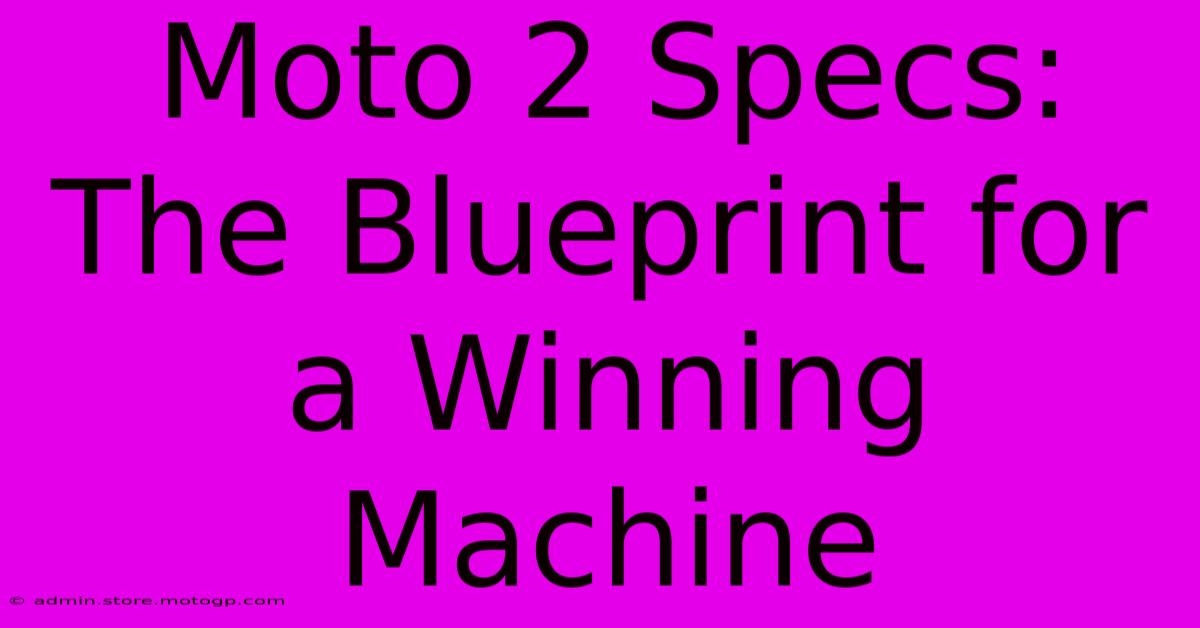Moto 2 Specs: The Blueprint For A Winning Machine

Table of Contents
Moto2 Specs: The Blueprint for a Winning Machine
The Moto2 class, a stepping stone to MotoGP, showcases incredible racing technology, refined and honed to deliver exhilarating competition. Understanding the technical specifications behind these machines reveals a fascinating blend of performance and regulation, creating a level playing field while pushing the boundaries of motorcycle engineering. This article delves into the key Moto2 specs, revealing the blueprint for a winning machine.
Engine: The Heart of the Beast
At the core of every Moto2 bike is a 765cc Triumph triple-cylinder engine. This isn't just any engine; it's a specifically designed and meticulously tuned unit, providing a potent balance of power and reliability. Key specs include:
- Displacement: 765cc
- Cylinder Configuration: Inline-three
- Fuel Injection: Sophisticated electronic fuel injection system for precise fuel delivery.
- Power Output: While exact figures aren't publicly released, it's understood to produce significantly more than 130bhp, offering thrilling acceleration and top speed. The power delivery is characterized by its smooth, linear nature, making it manageable yet exciting for riders.
The use of a standardized engine ensures fair competition, leveling the playing field and focusing development on chassis setup, electronics, and rider skill.
Chassis: The Foundation of Control
The chassis is where teams truly differentiate themselves. While the engine is standardized, the chassis design, including the frame, swingarm, and suspension, allows for considerable customization and fine-tuning. Key considerations here include:
- Frame Material: Typically aluminum, though some manufacturers experiment with carbon fiber components for weight reduction and improved stiffness.
- Suspension: Teams employ sophisticated adjustable suspension systems from leading manufacturers like Öhlins, allowing precise setup adjustments based on track conditions and rider preferences. Fine-tuning the suspension is crucial for optimal handling and stability.
- Swingarm: The swingarm plays a vital role in transferring power to the rear wheel and influencing handling characteristics. Design variations impact traction, stability, and agility.
- Geometry: Wheelbase, rake, and trail are carefully adjusted to optimize handling balance, offering a responsive yet stable ride.
The chassis is the canvas upon which teams paint their competitive edge.
Electronics: The Brain of the Operation
Modern Moto2 machines incorporate sophisticated electronics packages, further enhancing performance and rider control. While the specific details vary between teams, key elements often include:
- Traction Control: Minimizes wheelspin for optimal acceleration and stability.
- Engine Braking Control: Manages engine braking to improve stability under braking.
- Wheelie Control: Prevents excessive wheelies during acceleration.
- Launch Control: Aids in maximizing acceleration from a standstill.
- Data Acquisition Systems: Collects and analyzes vast amounts of data, allowing for precise setup adjustments and performance optimization.
These electronics systems provide riders with invaluable support, allowing them to push the limits of the machine with greater confidence.
Tyres: The Grip Factor
Tyre choice plays a pivotal role in Moto2 performance. Dunlop is the exclusive tyre supplier, providing a range of front and rear tyres tailored to specific track conditions. Tyre selection and management are crucial for race strategy and performance. The characteristics of the tyres influence grip, braking performance, and handling. Teams must carefully consider tyre wear and degradation throughout the race.
Conclusion: A Winning Formula
The Moto2 technical specifications represent a sophisticated blend of standardized components and areas for innovative development. The standardized engine ensures fair competition, while the freedom to develop the chassis, suspension, and electronics allows teams and riders to showcase their engineering prowess and riding skills. Understanding these specifications offers a deeper appreciation for the incredible machines and the intense competition of the Moto2 World Championship.

Thank you for visiting our website wich cover about Moto 2 Specs: The Blueprint For A Winning Machine. We hope the information provided has been useful to you. Feel free to contact us if you have any questions or need further assistance. See you next time and dont miss to bookmark.
Featured Posts
-
Circuit Of The Americas Reimagine Race Day Hospitality
Feb 20, 2025
-
Malaysian Moto Gp A Race Against Time
Feb 20, 2025
-
Who Will Start On Pole Moto Gp Qualifying Results Preview
Feb 20, 2025
-
Direct To The Action F1 Shuttle Service
Feb 20, 2025
-
Moto Gp Austin Dates Your Racing Weekend Awaits
Feb 20, 2025
